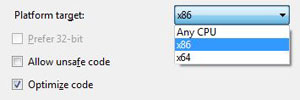Tag Archives: csharp
How to create and connect to an SQLite database in C#
The aim of this tutorial is to teach you how to create a new SQLite database from scratch, create a new table in it, insert and read values from it. This is merely an entry level example to give you an idea on how to start.
First you will need System.Data.SQLite library from system.data.sqlite.org. Head over to their download section and download the libraries that best suit your need depending on the .NET Framework you want to target and the Windows bit version.
Extract the file and add System.Data.SQLite.dll as a reference in your project. Keep in mind that SQLite.Interop.dll also needs to be in your executables directory but doesn’t need to be added as a reference in your project. Moreover, if your application is targeting Any CPU it is likely that you will get an exception. So make sure to navigate to Project properties -> Build and set the Platform target to the bit version of the System.Data.SQLite.dll binary you have downloaded.
Finally, the snippet below should give you the general idea on the main functions you will need to learn first, mainly
- Creating a file for your database
- Creating a table in your database
- Inserting information in the database
- Retrieving information from the database
Monitor clipboard in C#
The best way of monitoring the data in the clipboard through your application is by adding your application’s window to the chain of clipboard viewers so it can receive the WM_DRAWCLIPBOARD message when the clipboard data is modified.
In order to do that we need to make use of the Windows SetClipboardViewer and ChangeClipboardChain APIs in order to monitor when the WM_DRAWCLIPBOARD message triggers.
First we will need to pinvoke SetClipboardViewer and ChangeClipboardChain and WM_DRAWCLIPBOARD and also set the variables that will hold the value for the next window in the chain that is required when we will want to stop our window from monitoring the clipboard. Place the following in your class.
1 2 3 4 5 6 7 8 | [DllImport("User32.dll", CharSet = CharSet.Auto)] public static extern IntPtr SetClipboardViewer(IntPtr hWndNewViewer); [DllImport("User32.dll", CharSet = CharSet.Auto)] public static extern bool ChangeClipboardChain(IntPtr hWndRemove, IntPtr hWndNewNext); private const int WM_DRAWCLIPBOARD = 0x0308; // WM_DRAWCLIPBOARD message private IntPtr _clipboardViewerNext; // Our variable that will hold the value to identify the next window in the clipboard viewer chain |
Posted in C#.
Tagged C#, ChangeClipboardChain, csharp, SetClipboardViewer, snippet, tutorial, winforms, WM_DRAWCLIPBOARD
UDP hole punching implementation in C#
UDP hole punching is a method that is used to establish connectivity between two hosts that are behind a NAT (router) without the need of having the clients port forward specific ports.
When the client sends a UDP packet to the server the router creates a temporary rule mapping, the server then uses the incoming IP address and port it receives the message from to send a message to the client, which refreshes (in most cases) the lifetime of the temporary mapping on the client’s router and allows the server to communicate constantly with the client without the need for the user to do anything from their side.
This method is also used to send messages between two users that are behind different NAT’s. The difference in the implementation is that the clients first contact with the server, which should have a port open in order to be able to receive the information from the clients. After the server receives the information from the clients it sends each client the IP and port of the other client, allowing both of them to communicate with each other.
I’ve created a small example on how the implementation of a UDP hole punching looks in C#, this should give you the general idea of how it works and let you expand it as you like. The example simply receives a message from the client then sends a response. If you want the server to handle more than one message then you will need to add some loops.
How to hash a string with salt using a multi-algorithm method
It is considered a very bad idea to store user credentials in plain text, especially passwords. For that very reason it is always a good idea to hash passwords before you store them, ideally with a unique salt that you can store in another location. That way if for whatever reason your database is compromised your users passwords will not be in plain text and it will require a bit of work in order to find out what each password is, especially if the salt for each password is stored somewhere else.
The following method is a multi algorithm method, that means that with this single method you can use more than one algorithm to hash your data. The snippet below shows an example how to hash your data with a single method using seven different algorithms.
Our main method that will do all the work for us:
1 2 3 4 5 6 | private string StringToHash(string data, string salt, HashAlgorithm algorithm) { byte[] saltedBytes = Encoding.UTF8.GetBytes(data + salt); // Combine the data with the salt byte[] hashedBytes = algorithm.ComputeHash(saltedBytes); // Compute the hash value of our input return BitConverter.ToString(hashedBytes); } |
Host a process window inside your applications window
The following snippet will allow you to host the window of any application inside your own application. This isn’t a recommended practice but it’s a fun method that might spawn some interesting ideas.
In order to get this working we will need to pinvoke two Win32 functions, SetParent and SetWindowPos.
Place the following lines in your class
1 2 3 4 | [DllImport("user32.dll", SetLastError = true)] private static extern IntPtr SetParent(IntPtr hWndChild, IntPtr hWndNewParent); [DllImport("user32.dll", EntryPoint = "SetWindowPos")] public static extern IntPtr SetWindowPos(IntPtr hWnd, int hWndInsertAfter, int x, int Y, int cx, int cy, int wFlags); |









